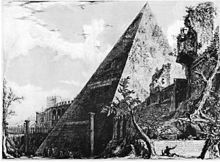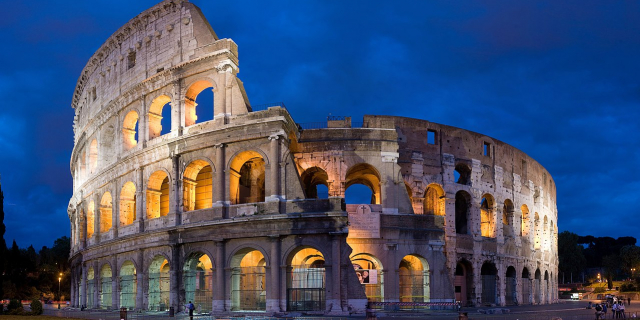Piramide Cestia
( Pyramid of Cestius )
The pyramid of Cestius (in Italian, Piramide di Caio Cestio or Piramide Cestia) is a Roman Era pyramid in Rome, Italy, near the Porta San Paolo and the Protestant Cemetery. It was built as a tomb for Gaius Cestius, a member of the Epulones religious corporation. It stands at a fork between two ancient roads, the Via Ostiensis and another road that ran west to the Tiber along the approximate line of the modern Via Marmorata. Due to its incorporation into the city's fortifications, it is today one of the best-preserved ancient buildings in Rome.
 Pyramid of Cestius by Giovanni Battista Piranesi (18th century)
Pyramid of Cestius by Giovanni Battista Piranesi (18th century)The pyramid was built for Gaius Cestius Epulo, the son of Lucius, of the tribe of Pobilia. The inscription on it mentions that Cestius was a praetor, a tribune of the plebs, and a septemvir of the Epulones. The tomb was completed in 330 days and was one of two pyramid shaped tombs in the city of Rome.[1] It is also important to note that its construction was regulated by sumptuary laws, which limit extreme displays of wealth such as in feasts, clothing, funerals, and tombs. While these laws can be traced back to the mid-5th century BC, they were much more strictly passed and enforced around the time of Cestius’ death.[2] The sharply pointed shape of the pyramid is strongly reminiscent of the pyramids of Nubia, in particular of the kingdom of Meroë, which had been attacked by Rome in 23 BC. The similarity suggests that Cestius had possibly served in that campaign and perhaps intended the pyramid to serve as a commemoration. His pyramid was not the only one in Rome; a larger one—the "pyramid of Romulus" — of similar form but unknown origins stood between the Vatican and the Mausoleum of Hadrian but was dismantled in the 16th century by Pope Alexander VI and the marble was used for the steps of St. Peter's Basilica.[3][4]
 Pyramid of Cestius and environs by Giuseppe Vasi (18th century)
Pyramid of Cestius and environs by Giuseppe Vasi (18th century)Some writers have questioned whether the Roman pyramids were modelled on the much less steeply pointed Egyptian pyramids exemplified by the famous pyramids of Giza. However, the relatively shallow Giza-type pyramids were not exclusively used by the Egyptians; steeper pyramids of the Nubian type were favored by the Ptolemaic dynasty of Egypt that had been brought to an end in the Roman conquest of 30 BC. The pyramid was, in any case, built during a period when Rome was going through a fad for all things Egyptian. The fusion of Roman and Egyptian styles is further highlighted by the fact that the exterior is distinctly "egyptianizing", while the interior displays classic Roman fresco paintings and a barrel vaulted ceiling.[5] The Circus Maximus was adorned by Augustus with an Egyptian obelisk,[6] and pyramids were built elsewhere in the Roman Empire around this time.[7]
 The pyramid was incorporated into the Aurelian Walls and is close to Porta San Paolo (on the right).
The pyramid was incorporated into the Aurelian Walls and is close to Porta San Paolo (on the right).During the construction of the Aurelian Walls between 271 and 275, the pyramid was incorporated into the walls to form a triangular bastion. It was one of many structures in the city to be reused to form part of the new walls, probably to reduce the cost and enable the structure to be built more quickly. It still forms part of a well-preserved stretch of the walls, a short distance from the Porta San Paolo.[8]
The origins of the pyramid were forgotten during the Middle Ages. The inhabitants of Rome came to believe that it was the tomb of Remus (Meta Remi) and that its counterpart near the Vatican was the tomb of Romulus, a belief recorded by Petrarch.[9][10] Its true provenance was clarified by Pope Alexander VII's excavations in the 1660s, which cleared the vegetation that had overgrown the pyramid, uncovered the inscriptions on its faces, tunnelled into the tomb's burial chamber and found the bases of two bronze statues that had stood alongside the pyramid.[3]
 Comparison of approximate profiles of notable pyramidal or near-pyramidal buildings. Dotted lines indicate original heights, where data is available. In its SVG file, hover over a pyramid to highlight and click for its article.
Comparison of approximate profiles of notable pyramidal or near-pyramidal buildings. Dotted lines indicate original heights, where data is available. In its SVG file, hover over a pyramid to highlight and click for its article.The pyramid was an essential sight for many who undertook the Grand Tour in the 18th and 19th centuries. It was much admired by architects, becoming the primary model for pyramids built in the West during this period.[11] Percy Bysshe Shelley described it as "one keen pyramid with wedge sublime" in Adonaïs, his 1821 elegy for John Keats. In turn the English novelist and poet Thomas Hardy saw the pyramid during a visit to the nearby Protestant Cemetery in 1887 and was inspired to write a poem, Rome: At the Pyramid of Cestius near the Graves of Shelley and Keats, in which he wondered: "Who, then was Cestius, / and what is he to me?"[12]
In 2001, the pyramid's entrance and interior underwent restoration. In 2011, further work was announced to clean and restore the pyramid's badly damaged marble cladding, through which water seepage has endangered the frescoes within. The restoration is sponsored by Japanese businessman Yuzo Yagi, whose €1-million donation resulted in a call for tenders to carry out the work issued by the Soprintendenza Speciale per i Beni Archeologici di Roma[13] whose officials drew up the project and are supervising such an intervention along with Italy's Ministry of Cultural Heritage.[14] Restoration work started in March 2013.[15]
The pyramid is the namesake of the Piramide station of the Rome Metro.[16]































Add new comment